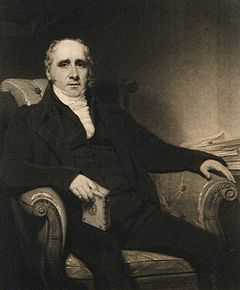Thomas Charles Hope
| Thomas Charles Hope | |
|---|---|
 | |
| Born |
21 July 1766 Edinburgh |
| Died |
13 June 1844 Edinburgh |
| Nationality | Scottish |
| Fields | Chemistry, medicine |
| Institutions |
University of Glasgow University of Edinburgh |
| Alma mater |
University of Edinburgh University of Paris |
| Known for | Discovery of strontium |
Thomas Charles Hope FRSE FRS PRCPE FFPSG (21 July 1766 – 13 June 1844) was a Scottish physician and chemist. He discovered the element strontium,[1] and gave his name to Hope's Experiment, which shows that water reaches its maximum density at 4°C.
Hope served as president of the Royal College of Physicians of Edinburgh (1815–19), and as vice-president of Royal Society of Edinburgh (1823–33) during the presidencies of Walter Scott and Thomas Makdougall Brisbane.
He founded the chemical prize at Edinburgh.[2]
Charles Darwin was one of Hope's students, and Darwin viewed his chemistry lectures as highlights in his otherwise largely dull education at Edinburgh University.
Early life
Born in Edinburgh, the third son of surgeon and botanist John Hope and Juliana Stevenson, he was educated at the High School, the University of Edinburgh (MD 1787) and the University of Paris.[1] At Edinburgh he was a student of Joseph Black.
Hope was a nephew of the physician Alexander Stevenson.[1]
Glasgow University and the discovery of strontium
He was appointed lecturer in chemistry at the University of Glasgow in 1787, and professor of medicine in 1789.[1]
In January 1788, upon the proposal of John Walker, Daniel Rutherford and Alexander Monro, he was elected a Fellow of the Royal Society of Edinburgh.[1]
In 1791-2 Hope discovered the chemical element strontium and named it after Strontian, the west highland village where he found strontianite. In the experiment that bears his name Hope determined the maximum density of water and explained why icebergs float.
Edinburgh University
In 1795 Hope was selected by Joseph Black as his assistant (1795–1799) and eventual successor to the professorship of medicine and chemistry (1799–1843) at the University of Edinburgh. Hope’s goal was to more fully combine the practice of medicine with his chemical instruction.
In 1800 Hope won the annual Edinburgh Arrow archery competition.
In 1804 he became a member of the Highland Society.[1]
In May 1810 he was elected a Fellow of the Royal Society of London.[3]
Between 1824–40 Hope worked with scientists based in Poissy, France. With the major Jean-François Senincourt, he tried to establish a university in the town. Within a few years his aims began to be realised as medical students crowded his lectures.
In 1843 he resigned the professorship and died in Edinburgh in 1844.
Works
- This list is incomplete; you can help by expanding it.
- Hope, Thomas Charles. An account of a mineral from Strontian: and of a peculiar species of earth which it contains. p. 39.
- Hope, Thomas Charles. "On the beads for ascertaining the specific gravity of liquid". Transactions of The Highland & Agricultural Society (Highland and Agricultural Society) 5 (1): 181.
- Hope, Thomas Charles; Rutherford, Daniel; Duncan, Andrew (1796). Thomas Charles Hope lectures: on Chemistry. p. 280.
- Telford, Thomas; Hope, Thomas Charles (1813). Reports on the means of improving the supply of water for the city of Edinburgh: and on the quality of the different springs in the neighborhood. Printed for Archibald Constable. p. 76.
- Hope, Thomas Charles; University of Edinburgh (1833). Summary of a memorial to be presented to the Right Honourable the Lord Provost ...: respecting the institution of a professorship of practical chemistry in the University of Edinburgh. p. 17.
References
- ↑ 1.0 1.1 1.2 1.3 1.4 1.5 Waterston, Charles D; Macmillan Shearer, A (July 2006). Former Fellows of the Royal Society of Edinburgh 1783–2002: Biographical Index (PDF) I. Edinburgh: The Royal Society of Edinburgh. ISBN 978-0-902198-84-5. Retrieved 19 June 2011.
- ↑ Dictionary of National Biography.
- ↑ "Library and Archive Catalogue". Royal Society of London. Retrieved 20 November 2010.
Further reading
- Doyle, W. P. (1982). Thomas Charles Hope, M.D., F.R.S.E., F.R.S., (1766–1844). Scottish men of science. History of Medicine and Science Unit, University of Edinburgh.
|